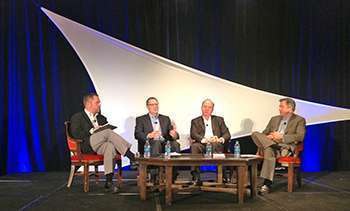 CCJ editor Jeff Crissey interviews a panel of fleet executives at the 2013 CCJ Fall Symposium.
CCJ editor Jeff Crissey interviews a panel of fleet executives at the 2013 CCJ Fall Symposium.In the next decade, the trucking industry must add 239,000 drivers, per year, to keep up with freight demand and replace the 37 percent today’s drivers that will retire. A panel of fleet executives discussed solutions to this pending crisis, Dec. 4, at the CCJ Fall Symposium in Scottsdale, Ariz.
The panel agreed that improving the public’s image of the transportation industry is the single biggest obstacle for attracting new drivers to the profession.
“We need to turn that ship in the right direction,” said panelist Keith Tuttle, president of Motor Carrier Service (MCS), a 100-truck carrier based in Toledo, Ohio. As part of the discussion on how to improve public image, the panel, moderated by CCJ Editor Jeff Crissey, discussed the Trucking Moves America Forward campaign, a new industry program.
Don Lefeve, executive director of the Commercial Vehicle Training Association (CVTA), added another obstacle to solving the crisis — federal and state funding for CDL schools. Congress has not dedicated funds to train workers for a career in transportation. CVTA represents 180 locations that train 50,000 drivers a year. The association has about 20 carrier partners that hire entry-level drivers.
Tuttle said MCS does not hire straight out of driving school. The company with its regional, Midwest operations received the 2012 “Best Fleet to Drive For” award from the Truckload Carriers Association. Its turnover rate is about 27 percent, he said.
“The best hire is somebody who has got experience. There is a much higher turnover rate with guys who are right out of school,” he said. In recent months, however, Tuttle has noticed an alarming trend among his long-tenured drivers. “Drivers who are leaving now have been with us for 10 to 15 years.”
Tuttle didn’t have an explanation for why long-tenured drivers are changing jobs, but he expressed concern about the dwindling supply of qualified drivers.
“Most good carriers will not hire a large percentage of drivers,” he continued. “We will look at one out of 150 applications sent to us. We do very well financially but we are frustrated with our ability to show substantial growth with the driver situation right now.”
Panelist John Hancock, director of training and driver recruiting for Prime, Inc., added that the carrier sees a large number of applicants who, for various reasons, are not employable for any job due to serious flaws in their work history. Prime, based in Springfield, Mo., has 5,300 power units and 6,300 drivers with tanker, reefer and flatbed operations.
Prime has a turnover rate of 61 percent, far below the average rate for large truckload carriers. The company is focused on creating opportunities for its employees and contractors to maximize their income and see trucking as a good career choice.
“We need to generate a work force that wants to do this,” he said. “People want a good job.” The definition of “good job” varies by person, he added, but everyone wants a good income and opportunity for growth to fulfill their basic needs.
Hancock cited studies from a book, The Coming Jobs War by Jim Clifton, that 20 percent of people in the United States are underemployed. The book also says only 28 percent of employees are engaged and trying to line themselves up with the company’s objectives. Fifty-three percent are not engaged and are “just showing up.”
“We want to have much a higher number engaged,” he said. “We believe in weekly measures. All associates are paid this week based on what happened last week.” Drivers also receive a weekly fuel bonus.
“If we can give people a vehicle to accomplish (income growth), they will come and be part of that,” he said.
MCS will be raising driver pay this week, Tuttle said. About half of its drivers made over $55,000 last year. Some made more than $65,000 and are home 10 to 13 nights per month on average. Its drivers are also involved in planning routes and rating customers.
“We actually fired a good customer three weeks ago for some of their detention policies,” Tuttle said.
The panel agreed that health and wellness programs are part of the solution to creating good jobs for drivers. Prime has created a “Fittest of the Fleet” competition in addition to participating in TCA’s Weight Loss showdown. The panelists also agreed that having new equipment spec’d with creature comforts has become standard fare for attracting over-the-road drivers.













